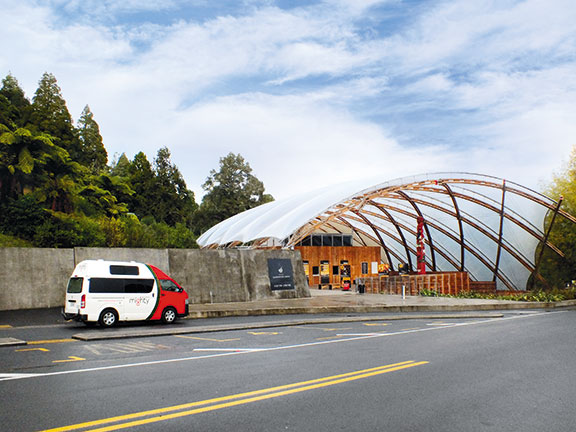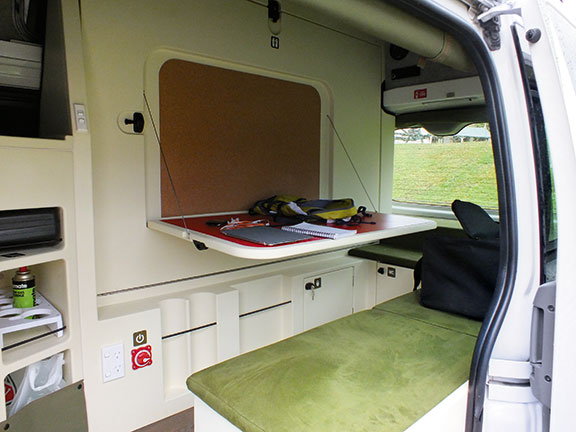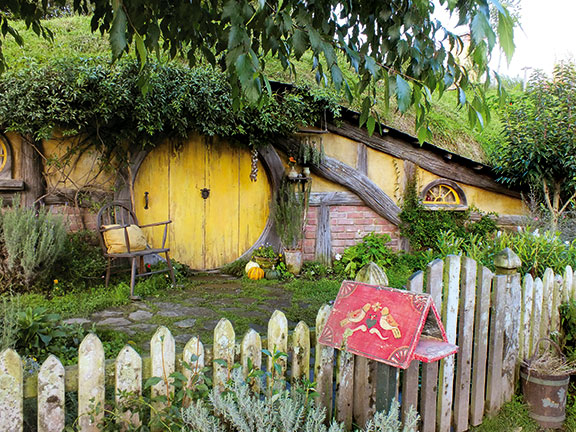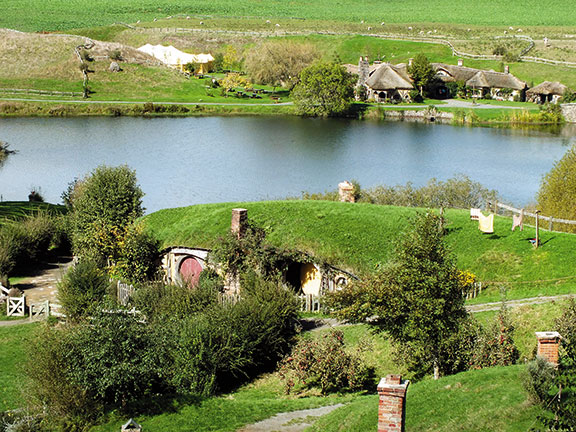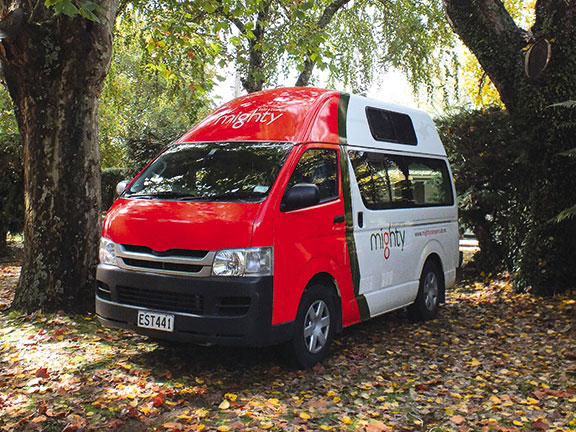Fitting more into less, whether it's more features into a smaller package or more activities into a shorter timeslot, getting the most value for money from any situation is an irrefutable component of the human condition.
Recently I experienced a double whammy in the value stakes, managing not only to secure a spot on a self-guided driving tour taking in three separate North Island destinations loosely linked by a unifying theme (more on that in a mo'), but I also journeyed this way and that in a compact camper that still packed myriad features into a small footprint.
The van was supplied by Mighty Campers — a part of the extensive THL network aimed primarily at the more budget-conscious end of the market — and was a converted Toyota Hiace ZL, powered by a gutsy 2.7-litre petrol engine, with a four-speed automatic transmission.
Known as The Jackpot, my three-berth camper is one of five different models on offer in the Mighty range, which stretches from the backpacker-friendly two-berth Lowball at one end of the menu, to the four-berth Double-Up at the other.
The Jackpot sits pretty much in the middle of the Mighty Campers line up, but still manages to err on the side of convenience despite its standard van format. The high-roofed Jackpot is fitted with a sink and comes with a perfectly spacious 45-litre fridge. There's a portable stove supplied, which runs off quick and easy butane canisters, along with a Thetford Porta-Potti that sits in dedicated space under the rear bench. Crockery, utensils, cooking equipment and tea towels are all supplied, as is bedding, pillows and bath towels.
The Jackpot's clever party piece, though, is its fold-out table and double bed combo. Rather than having to bother with fitted bed-boards when the sun dips below the horizon, simply unlatch the bed from its hidey-hole against the van's right-hand internal wall, and the entire unit — comfy, permanently attached foam mattress and all — arcs down in damped soft-open fashion.
During daylight hours, a smaller inset in this same wall folds out to become a decently-sized table, accommodating all who sit around the Jackpot's L-shaped rear seats. Once the bed has been folded into its evening layout, the recess between bed and van wall reveals a clever arrangement of fabric storage pockets for torches, bedtime reading, emergency winter extra layers and more. Up above, there's a fold-out hammock for the third occupant, although I'd be playing paper-rock-scissors to avoid bunking there myself.
Okay, so with more-into-less wheeled accommodation sorted, what of my feature-packed itinerary?
As is fitting for a journey across the middle of the North Island, it's Tolkien-themed. The Hobbit Trilogy is a new self-guided itinerary suggestion that takes in well-known sights at Waitomo (deep caves), Rotorua (bubbling mud) and, of course, Matamata (the home of the Shire movie set from the Lord of the Rings and Hobbit movies).
The self-drive nature of the Hobbit Trilogy means it's up to you what order you visit the sights in, but having never been to Hobbiton before, I decided to save that 'til last and check out the amazing cave systems at Waitomo, about an hour south-west of Hamilton, first.
Billed as one of New Zealand's 'must sees', there are actually three parts to the cave system open to the public — the glow worm caves, Aranui Cave and Ruakuri Cave. Unique to New Zealand, the famous glow worms (arachnocampa luminosa, for those playing along at home) provide a galaxy of luminescent light, best viewed from the boat of an expert guide who takes you deep into this underground world.
I was most impressed, however, with Ruakuri Cave (translated from Maori as 'den of the dogs', so named after a pack of wild dogs that used the cave entrance as shelter some 400-500 years ago). To access the sprawling network of systems — which are expertly guided too, I might add — visitors descend a spectacular spiral staircase. As your eyes adjust to the dark (there is unobtrusive lighting throughout the tour), you are greeted by otherworldly stalactites, stalagmites, fragile shawl-like limestone formations and the rumble of an underground waterfall. You could well imagine running into Gollum himself along some darkened path down here.
Returning to the surface, I stayed at the nearby Waitomo Top 10 Holiday Park which, despite this being a decidedly wet off-season weekend, remained busy with myriad international accents. The facilities here are top notch and just across the road from Waitomo village's commercial hub, too (namely a general store, tourist information point and bar and restaurant).
The following day saw me travel 145km east to Rotorua: not so much an 'unexpected journey' of the Hobbit variety, as a well-planned stage two of my trilogy trip. Fetching up at the sprawling, leafy Rotorua Thermal Holiday Park site, I was delighted to note its location just down the road from the Te Puia cultural centre and its famous Te Whakarewarewa geothermal reserve.
Once the site of a fortified pa, the cultural centre still boasts guides descended from original Te Puia inhabitants. It's a rare treat to walk through a bubbling, plopping, steaming landscape like this: there are few sites on earth showcasing such extremes of geothermal activity — over 500 hot pools and 65 geyser vents — in such a condensed space. The comparisons between Te Puia and Tolkien's Middle Earth are easily noted at every turn.
My final day saw me trek north again to a farm at Hinuera, about 10 minutes outside Matamata, to visit what is arguably the main attraction in the Hobbit Trilogy tour — Peter Jackson's wonderfully detailed Shire movie set, known as Hobbiton.
The stats surrounding Hobbiton are incredible and the scale of the place has to be seen to be believed — 37 Hobbit holes, an oak tree cut down and brought on site piece by piece to sit overlooking Bag End (and for which every single fake leaf has been hand-painted and applied), three-meal-per-day catering for up to 400 people on set during the height of filming, one person specifically employed to tread up and down every day in the grass between Hobbit holes, making realistic foot tracks between front doors and washing lines... It's a movie trivia lover's goldmine.
I'm no rabid Tolkien fan, but looking around this unique spot on the Alexander family farm (Hobbiton is run as a joint venture between the Alexander family and Peter Jackson) and taking in the attention to detail and craftsmanship involved in bringing the Shire scenes to the big screen proved a fascinating experience. I was more than a little sad to be brought back to 21st century reality as the tour bus arrived to take us back to the Shires Rest Cafe after an hour or so at the site.
Much like the cleverly packaged Jackpot I drove home, I'd managed to fit three fun-filled tours into one quick jaunt — a pleasing aspect of motorhoming in this part of the world. More into less, achieved once again.
For the latest reviews, subscribe to our Motorhomes, Caravans & Destinations magazine here.

The road to Milford Sound
Explore the awe-inspiring journey to Milford Sound through Fiordland National Park – from scenic DOC campsites and iconic hikes to wildlife cruises and luxury stays

